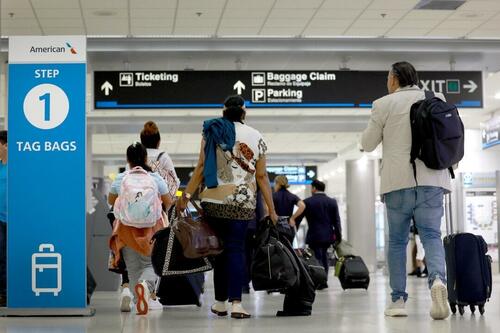Authored by Naveen Athrappully via The Epoch Times,
Friday set a new record for the most airline passengers screened by U.S. Transportation Security Administration (TSA) officials in a single day, according to the agency.
“On Friday, May 24, 2,951,163 individuals were screened at checkpoints nationwide, surpassing the previous record on Nov. 26, 2023. We recommend arriving early,” the TSA said in a May 25 post on the social media platform X.
On Nov. 26 last year, the TSA screened a slightly lower figure of 2.90 million travelers. The third-highest screened day was on May 23, when officers screened 2.89 million people.
The record numbers come days after the TSA said it was prepared for the “highest passenger volumes the agency has seen at airport security checkpoints nationwide during this summer’s travel season,” according to a May 16 press release. The summer travel season begins on the Memorial Day weekend and runs through Labor Day.
The agency forecasted that May 24 would be the busiest travel day of the Memorial weekend, anticipating almost three million passengers.
For the week of May 23-29, the TSA expects to screen over 18 million passengers and crew, which would be a 6.4 percent increase in checkpoint volume compared to the same period last year.
TSA Administrator David Pekoske said the agency was coordinating with airport, airline, and travel partners and was “more than ready” to handle the expected high travel volumes.
“We are also continuing to deploy state-of-the-art checkpoint technology that increases security effectiveness, efficiency and enhances the passenger experience and our retention and recruitment numbers are the highest they’ve ever been.”
Airlines for America (A4A), an association of airline companies, also predicts a “record-setting” summer season for air travel this year.
In a May 14 press release, A4A forecasts that U.S. airlines will carry 271 million passengers worldwide this summer season between June 1 and Aug. 31, a 6.3 percent increase from last summer. If the prediction comes true, it’ll eclipse the previous record set last year when 255 million individuals went airborne.
To accommodate higher demand, U.S. carriers will be offering more flights this summer. Airlines have planned more than 26,000 scheduled flights per day for the season, up by over 1,400 from 2023.
“Our carriers have adjusted their schedules to adapt to current realities of our National Airspace System (NAS), helping to alleviate some of those pressure points and making for a smooth summer travel season,” A4A’s senior vice president of communications, Rebecca Spicer, said.
Profitability of Airlines
The higher U.S. airline passenger numbers come as the industry attempts to consistently match pre-pandemic operating revenue levels.
Between 2013 and 2019, operating revenues netted more than $200 billion every single year. Revenues in 2018 came in at $240 billion, which increased to $248 billion in 2019.
In 2020, following worldwide restrictions and lockdowns, revenues crashed to $131 billion, then rose to $194 billion in 2021, and netted nearly $280 billion in 2022. However, revenues fell to $223 billion in 2023.
The International Air Transport Association (IATA) is expecting the global airline industry’s net profits to hit $25.7 billion in 2024, a slight improvement from 2023’s $23.3 billion. This points to a 2.7 percent net profit margin rate for the year.
Willie Walsh, the IATA’s director general, pointed out that the $25.7 billion net profit in 2024 is a “tribute to aviation’s resilience” given the major losses the industry suffered in recent years.
However, industry profits “must be put into proper perspective,” he said. “A net profit margin of 2.7 percent is far below what investors in almost any other industry would accept ... On average, airlines will retain just $5.45 for every passenger carried. That’s about enough to buy a basic ‘grande latte’ at a London Starbucks.”
Even though operating profits in 2024 are expected to jump by 21.1 percent, net profit margins are only projected to rise by 10 percent, which the IATA blames mostly on increased interest rates.
New Screening Protocols
Meanwhile, the TSA announced that airline passengers could expect to encounter some new checkpoint technologies this year.
For instance, the agency is using the second generation Credential Authentication Technology (CAT-2). Like its earlier version CAT, the updated CAT-2 will confirm the authenticity of a passenger’s identity with their photo ID as well as flight details and pre-screening status.
However, the updated version comes with new camera features, with passengers potentially having to agree to have a photo of them taken in real time for identity verification. This is done to ensure that “the person standing at the checkpoint is the same person pictured on their ID,” the agency said.
The TSA highlighted that photos taken will not be stored or saved after a positive ID match has been made. However, the agency said it may retain the image for conducting tests to evaluate tech effectiveness.
“Passengers who do not want their photo taken may ask the Transportation Security Officer (TSO) for a manual ID check without penalty and losing their place in line.”
Multiple airports have also installed Computed Tomography (CT) units, which the agency claims will “significantly improve” scanning and threat detection of carry-on bags. CT units generate a 3D image of passengers’ bags, thus reducing the need to physically search their contents.
The TSA has so far deployed 2,050 CAT units at 223 airports, out of which 238 units are the updated CAT-2 versions. The agency has set up over 820 CT units at more than 240 airports.
